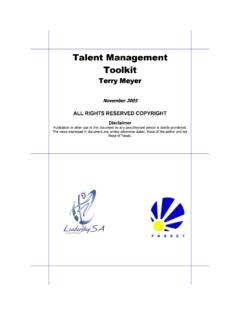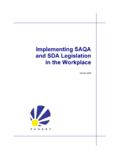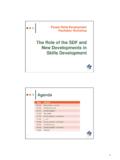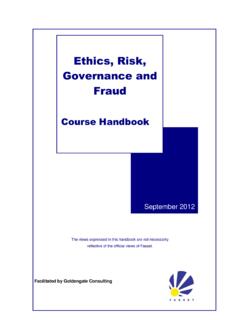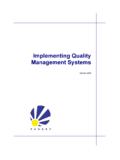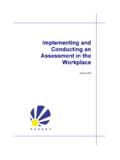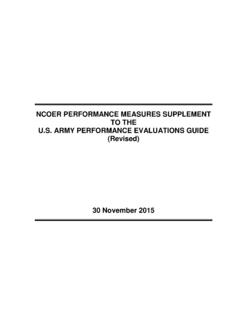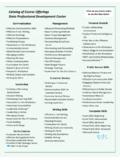Transcription of Management & Leadership Handbook - Fasset
1 Management & Leadership Handbook November 2012 Facilitated by Faranani Facilitation Services Pty Ltd The views expressed in this document are not necessarily those of Fasset s. Management & Leadership Handbook (2012) 2 Table of Contents SECTION 1: INTRODUCTION TO Management & Leadership .. 6 Differentiating between Management and Leadership .. 6 Factors of Leadership : .. 7 Leadership challenges at work .. 13 Management challenges at work .. 14 SECTION 2: PRACTISING EFFECTIVE Leadership .. 17 Recognising Leadership Styles: .. 17 Effective delegation and situational Leadership .
2 22 The Managerial Grid: Blake and Mouton .. 24 Four development levels of followers .. 25 The four situational Leadership styles .. 26 Adapting your Leadership style .. 27 Influencing and motivating your team .. 28 The Art of Persuasion and Negotiation .. 29 The Speed of Trust The Heart of Leadership .. 32 SECTION 3; PRACTISING EFFECTIVE Management .. 36 The Essentials of Management .. 36 Essentials of Management 1 = Planning .. 36 Basic Overview of the Typical Phases in Planning: .. 37 Guidelines to Ensuring Successful Planning and Implementation .. 38 Essentials of Management 2 = Organising.
3 41 The Process of Organising .. 41 Organisational Theories .. 42 Essentials of Management 3 = Controlling .. 42 Tools of Control .. 43 The Top Ten Qualities of an Excellent Manager .. 44 Interviewing and Selection Skills .. 45 Running Effective Meetings .. 47 Management & Leadership Handbook (2012) 3 How do you prepare for a Meeting: .. 48 Some Tips on Running Weekly Team Meetings .. 48 Arrangements Prior to the Meeting .. 49 Logistics- planning and organising your meeting or training activity .. 50 How to Arrange a Room .. 51 Standard Items on an Agenda .. 51 Conducting Meetings.
4 52 Communication and Meetings .. 53 Effective Meetings .. 54 Secrets to Successful Business Meetings .. 54 How to deal with Disruptive Individuals at Meetings .. 56 Making Effective and Impactful Presentations .. 57 Managing Performance .. 61 Examples of Organisational Performance Standards .. 62 Appraisal skills dealing with poor performance .. 68 Creating a Performance Improvement Plan .. 71 Giving Effective Feedback .. 72 Stretching your Team to Develop .. 73 Feelings .. 74 Values .. 74 Needs .. 74 Guidelines for Stretching your team to develop them further: .. 77 Decision Making and Delegation Skills.
5 79 SECTION 4: CREATING HIGH PERFORMANCE TEAMS .. 83 Teamwork in Action .. 83 Team Learning and 84 Making the Most of Team Learning .. 84 Team Evolution Stages .. 86 Managing Remote Teams .. 88 Coaching and Mentoring Skills for Managers .. 90 Management & Leadership Handbook (2012) 4 Types of Mentoring .. 91 Eight Pillars of Coaching and Mentoring .. 92 Limitations of 95 Coaching vs. Mentoring .. 95 95 Benefits of Coaching .. 95 Limitations of Coaching .. 96 Coaching and mentoring connection process .. 96 Managing of Challenging Behaviours .. 97 Managing Pressure: Urgency vs Important.
6 99 Strategies for Different Quadrants on the Matrix .. 100 SECTION 5: MANAGING CHANGE, COMMUNICATION AND ACTION PLANS .. 103 Understanding Change and How Teams Respond .. 103 Understanding what change is .. 103 The content and process dimensions of change .. 104 Why do Organisations Resist Change .. 105 Overcoming Resistance .. 106 Managing Change Effectively .. 107 Developmental Change .. 107 Transitional Change .. 108 Transformational Change .. 108 The Role of Change in the 112 Drivers of change .. 114 Elements of change .. 115 Effective Communication .. 116 Full and Active Executive Support.
7 116 Employee Involvement .. 117 Kotter s Change Model .. 119 Effective Communication Skills .. 122 Improving internal communications .. 123 Management & Leadership Handbook (2012) 5 Getting Things Done: Practical Action Planning .. 124 REFERENCES .. 127 USEFUL LINKS .. 129 Management & Leadership Handbook (2012) 6 SECTION 1: INTRODUCTION TO Management & Leadership Management is efficiency in climbing the ladder of success; Leadership determines whether the ladder is leaning against the right wall." Stephen R. Covey Differentiating between Management and Leadership Leadership and Management are two notions used to describe two related concepts.
8 Managers do things right, leaders do the right thing. But this distinction is too facile and too simple. Leadership has two implied meanings. It can be defined in terms of position, as in being in a Leadership position. A more fruitful way to think about Leadership concerns the distinction between occupying a Leadership position and being effective in that position. Leadership ought to be evaluated in terms of the performance of the group over time. It relates directly to the ability to build and maintain a group that performs well compared to its competition.
9 In this section, these differences are discussed, explaining why both terms are thought to be similar. Leadership is just one of the many assets a successful manager must possess. The principal aim of a manager is to maximize the output of the organisation through administrative implementation. To achieve this, managers must undertake the following functions: organisation planning staffing controlling directing Leadership is an important component of the directing function. A manager must manage as well as lead. Managers need formal authority to be effective.
10 This involvement cannot be delegated. Moreover, in many day-to-day circumstances, Leadership is not required. For example, in answering routine emails and phone calls or in assigning daily work responsibilities, a leader is simply managing or transacting business. Often with small groups, it is not the top manager who emerges as the actual leader. In many cases it is a subordinate member with specific talents who leads the group in a certain direction. Leaders must often let vision, strategies, goals, and values guide the group action and behaviour rather than attempting to control others.
